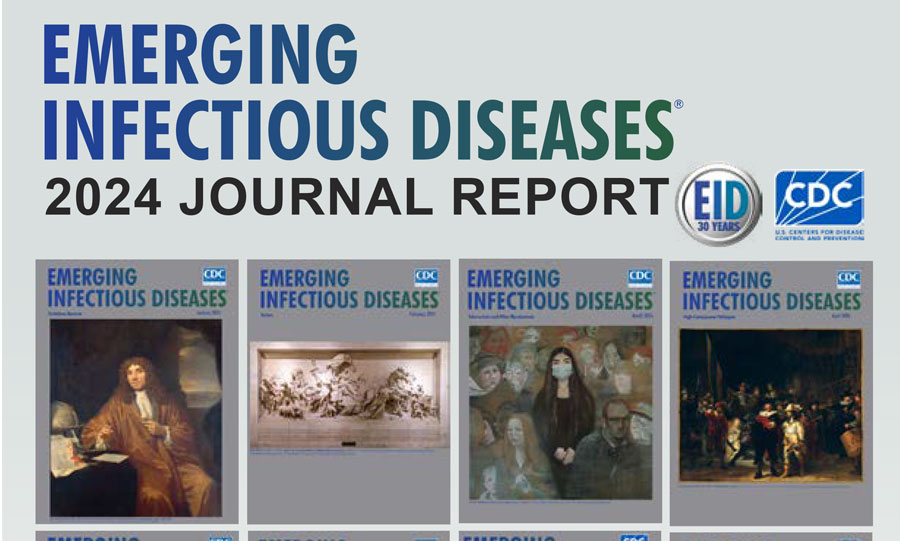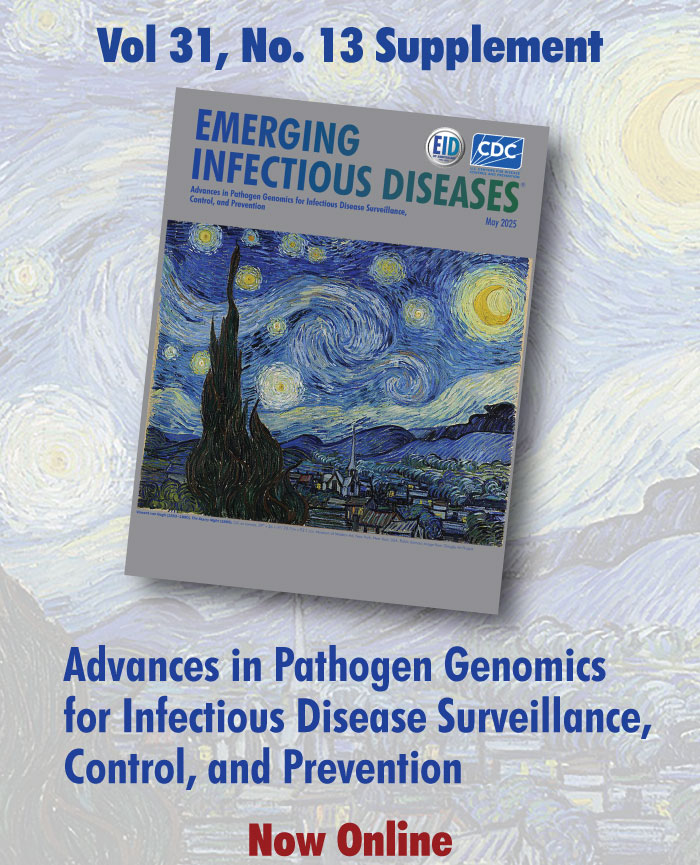Medscape CME Activity
Medscape, LLC is pleased to provide online continuing medical education (CME) for selected journal articles, allowing clinicians the opportunity to earn CME credit. In support of improving patient care, these activities have been planned and implemented by Medscape, LLC and Emerging Infectious Diseases. Medscape, LLC is jointly accredited by the Accreditation Council for Continuing Medical Education (ACCME), the Accreditation Council for Pharmacy Education (ACPE), and the American Nurses Credentialing Center (ANCC), to provide continuing education for the healthcare team.
CME credit is available for one year after publication.
Volume 31—2025
Volume 31, Number 12—December 2025
A previous study demonstrated noninferior efficacy of 4-month rifapentine/moxifloxacin regimen for tuberculosis (TB) treatment compared with the standard regimen. We analyzed pregnancy outcomes of women who became pregnant during the study. Among 740 women, 97 (13.1%) became pregnant. Of 102 pregnancies (in 97 participants), 30 (29.4%) participants were exposed to study drugs. Fetal loss was reported for 3/13 (23.1%) in the control regimen, 1/9 (11.1%) in the rifapentine/moxifloxacin regimen, and 1/8 (12.5%) in the rifapentine regimen. Among 21 live births in exposed pregnancies (7 in each arm), 1 infant with a congenital anomaly was reported in a participant on the rifapentine regimen. Among women receiving a short rifapentine/moxifloxacin regimen for tuberculosis who became pregnant, we observed no elevated rates of fetal losses or congenital anomalies.
| EID | Kurbatova EV, Whitworth WC, Bryant KE, Dixon MG, Dooley KE, Scott NA, et al. Pregnancy Outcomes after Exposure to Tuberculosis Treatment in Phase 3 Clinical Trial, 2016–2020. Emerg Infect Dis. 2025;31(12):2219-2228. https://doi.org/10.3201/eid3112.250492 |
|---|---|
| AMA | Kurbatova EV, Whitworth WC, Bryant KE, et al. Pregnancy Outcomes after Exposure to Tuberculosis Treatment in Phase 3 Clinical Trial, 2016–2020. Emerging Infectious Diseases. 2025;31(12):2219-2228. doi:10.3201/eid3112.250492. |
| APA | Kurbatova, E. V., Whitworth, W. C., Bryant, K. E., Dixon, M. G., Dooley, K. E., Scott, N. A....Phillips, P. (2025). Pregnancy Outcomes after Exposure to Tuberculosis Treatment in Phase 3 Clinical Trial, 2016–2020. Emerging Infectious Diseases, 31(12), 2219-2228. https://doi.org/10.3201/eid3112.250492. |
Volume 31, Number 11—November 2025
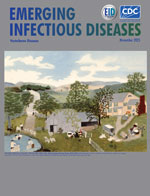
Haematospirillum jordaniae was first identified as a human pathogen in 2016. In this article, we describe 4 patients who had H. jordaniae infections identified in 2020 and who had temporally and spatially linked environmental exposures. Three of the 4 patients reported leg injuries while participating in recreational river water activities in south-central Pennsylvania, USA. In 2024, we detected H. jordaniae in river samples collected at locations identified during patient interviews. All patients sought emergency department services for clinical assessment; however, the causative bacterial isolate was not initially identified. H. jordaniae was identified as the bacterial cause months after patient treatment and discharge. Although H. jordaniae infections are considered rare, the true occurrence is unknown. Additional information about the organism’s ecology and environmental seasonality could guide public health messaging and increase awareness among healthcare providers.
| EID | Dulcey M, DeBord KM, Bell ME, Murray MT, Szewc AM, Livingston K, et al. Haematospirillum jordaniae Infections after Recreational Exposure to River Water, Pennsylvania, USA, 2020. Emerg Infect Dis. 2025;31(11):2073-2079. https://doi.org/10.3201/eid3111.241586 |
|---|---|
| AMA | Dulcey M, DeBord KM, Bell ME, et al. Haematospirillum jordaniae Infections after Recreational Exposure to River Water, Pennsylvania, USA, 2020. Emerging Infectious Diseases. 2025;31(11):2073-2079. doi:10.3201/eid3111.241586. |
| APA | Dulcey, M., DeBord, K. M., Bell, M. E., Murray, M. T., Szewc, A. M., Livingston, K....Bower, W. A. (2025). Haematospirillum jordaniae Infections after Recreational Exposure to River Water, Pennsylvania, USA, 2020. Emerging Infectious Diseases, 31(11), 2073-2079. https://doi.org/10.3201/eid3111.241586. |
Volume 31, Number 10—October 2025

Candida bloodstream infections, and their increasing antifungal resistance, are a global concern. In this cross-sectional study, we analyzed 2,443 culture-confirmed candidemia cases reported in South Africa during 2012–2017 to assess the effect of previous antifungal exposure on nonsusceptible Candida infection. We classified cases by species resistance profile and patient’s antifungal use within 14 days before infection. We found that 48% of cases were caused by nonsusceptible species, and 20% of patients had prior antifungal exposure, mainly to fluconazole. In patients >90 days of age, prior antifungal use was significantly associated with nonsusceptible Candida bloodstream infection (adjusted OR 2.02, 95% CI 1.43–2.87; p<0.001), with species-specific effects. No such association was found in neonates and young infants, for whom hospital transmission appeared more influential. Our findings underscore the need for targeted antifungal stewardship and enhanced infection prevention to mitigate antifungal resistance in South Africa.
| EID | Rabault C, Shuping L, Mpembe R, Quan V, Lanternier F, Lortholary O, et al. Recent Systemic Antifungal Exposure and Nonsusceptible Candida in Hospitalized Patients, South Africa, 2012–2017. Emerg Infect Dis. 2025;31(10):1901-1911. https://doi.org/10.3201/eid3110.250359 |
|---|---|
| AMA | Rabault C, Shuping L, Mpembe R, et al. Recent Systemic Antifungal Exposure and Nonsusceptible Candida in Hospitalized Patients, South Africa, 2012–2017. Emerging Infectious Diseases. 2025;31(10):1901-1911. doi:10.3201/eid3110.250359. |
| APA | Rabault, C., Shuping, L., Mpembe, R., Quan, V., Lanternier, F., Lortholary, O....Govender, N. P. (2025). Recent Systemic Antifungal Exposure and Nonsusceptible Candida in Hospitalized Patients, South Africa, 2012–2017. Emerging Infectious Diseases, 31(10), 1901-1911. https://doi.org/10.3201/eid3110.250359. |
Reptile-associated outbreaks of human Salmonella infections are increasing in Canada, coinciding with a rise in the popularity of reptiles as pets. We conducted a retrospective analysis of surveillance data for human Salmonella case-patients in Ontario during 2015–2022. We compared serotypes and reptile types for those reporting domestic reptile or amphibian exposure with veterinary Salmonella isolates reported during the same period. Case-patients commonly reported contact with reptile types from which Salmonella was most frequently isolated. Some serotypes from human case-patients were closely associated with contact with specific reptile types, including Salmonella Paratyphi B biovar Java (Salmonella Paratyphi B variant L (+) tartrate +) with snakes, Salmonella Agbeni with turtles, and Salmonella Cotham, Salmonella Chester, and Salmonella Tennessee with bearded dragons. Salmonella was most likely to be reported from reptiles fed a carnivorous diet. Education of reptile owners could help promote proper veterinary care and reduce transmission of zoonotic infections.
| EID | Paphitis K, Reid A, Golightly HR, Adams JA, Corbeil A, Majury A, et al. Reptile Exposure in Human Salmonellosis Cases and Salmonella Serotypes Isolated from Reptiles, Ontario, Canada, 2015–2022. Emerg Infect Dis. 2025;31(10):1912-1921. https://doi.org/10.3201/eid3110.241803 |
|---|---|
| AMA | Paphitis K, Reid A, Golightly HR, et al. Reptile Exposure in Human Salmonellosis Cases and Salmonella Serotypes Isolated from Reptiles, Ontario, Canada, 2015–2022. Emerging Infectious Diseases. 2025;31(10):1912-1921. doi:10.3201/eid3110.241803. |
| APA | Paphitis, K., Reid, A., Golightly, H. R., Adams, J. A., Corbeil, A., Majury, A....McClinchey, H. (2025). Reptile Exposure in Human Salmonellosis Cases and Salmonella Serotypes Isolated from Reptiles, Ontario, Canada, 2015–2022. Emerging Infectious Diseases, 31(10), 1912-1921. https://doi.org/10.3201/eid3110.241803. |
Volume 31, Number 9—September 2025
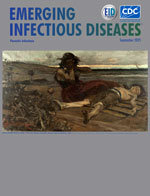
Sierra Colomina M, Flamant A, Le Balle G, Cohen JF, Berthomieu L, Leteurtre S, et al. Severe group A Streptococcus infection among children, France, 2022–2024. Emerg Infect Dis. 2025 Sep [date cited]. https://doi.org/10.3201/eid3109.250245
Group A Streptococcus infections have increased in Europe since September 2022. The French Pediatric Intensive Care and French Pediatric Infectious Diseases expert groups conducted a retrospective and prospective study of children who had severe group A Streptococcus infections during September 1, 2022–April 1, 2024, across 34 hospitals in France. A total of 402 pediatric patients (median age 4 [interquartile range 2–7.5] years; 42% girls, 58% boys) were enrolled. Cases were characterized by a low proportion of severe skin and soft tissue infections (16%), predominance of severe upper and lower respiratory tract infections (55%), and a 3.5% case-fatality rate. In multivariate analysis, hydrocortisone, corticosteroid, and vasopressor therapies were significantly associated with major sequelae or death. Molecular analysis revealed emm1 (73.0%) and emm12 (10.8%) strains; the M1UK clone represented 50% of emm1 strains. Clinicians, researchers, and public health authorities must collaborate to mitigate the effects of GAS on child health.
| EID | Colomina M, Flamant A, Le Balle G, Cohen JF, Berthomieu L, Leteurtre S, et al. Severe Group A Streptococcus Infection among Children, France, 2022–2024. Emerg Infect Dis. 2025;31(9):1698-1707. https://doi.org/10.3201/eid3109.250245 |
|---|---|
| AMA | Colomina M, Flamant A, Le Balle G, et al. Severe Group A Streptococcus Infection among Children, France, 2022–2024. Emerging Infectious Diseases. 2025;31(9):1698-1707. doi:10.3201/eid3109.250245. |
| APA | Colomina, M., Flamant, A., Le Balle, G., Cohen, J. F., Berthomieu, L., Leteurtre, S....Brehin, C. (2025). Severe Group A Streptococcus Infection among Children, France, 2022–2024. Emerging Infectious Diseases, 31(9), 1698-1707. https://doi.org/10.3201/eid3109.250245. |
The complexity of rickettsial serodiagnostics during acute illness has limited clinical characterization in Africa. We used archived samples from sepsis (n = 259) and acute febrile illness (n = 70) cohorts in Uganda to identify spotted fever and typhus group rickettsiae by using immunofluorescence assay and clinically validated rRNA reverse transcription PCR (RT-PCR). Among 329 participants, 10.0% had rickettsial infections (n = 33; n = 20 identified with immunofluorescence assay and n = 13 by RT-PCR). Serum rRNA RT-PCR was 75.0% (95% CI 42.8–94.5%) sensitive and 91.2% (95% CI 85.8–95.1%) specific. Thrombocytopenia was more common among patients with rickettsial infections than with other nonmalarial infections (adjusted odds ratio 3.7; p = 0.003). No participants were on a tetracycline antimicrobial drug at admission. rRNA RT-PCR is a promising diagnostic strategy for identifying acute rickettsial infections. Doxycycline should be included in empiric antimicrobial drug regimens for nonmalarial febrile illness in this region.
| EID | Blair PW, Alharthi S, Londoño AF, Wailagala A, Manabe YC, Dumler J. Rickettsioses as Underrecognized Cause of Hospitalization for Febrile Illness, Uganda. Emerg Infect Dis. 2025;31(9):1708-1717. https://doi.org/10.3201/eid3109.250479 |
|---|---|
| AMA | Blair PW, Alharthi S, Londoño AF, et al. Rickettsioses as Underrecognized Cause of Hospitalization for Febrile Illness, Uganda. Emerging Infectious Diseases. 2025;31(9):1708-1717. doi:10.3201/eid3109.250479. |
| APA | Blair, P. W., Alharthi, S., Londoño, A. F., Wailagala, A., Manabe, Y. C., & Dumler, J. (2025). Rickettsioses as Underrecognized Cause of Hospitalization for Febrile Illness, Uganda. Emerging Infectious Diseases, 31(9), 1708-1717. https://doi.org/10.3201/eid3109.250479. |
Volume 31, Number 8—August 2025
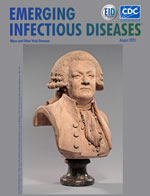
Mpox was first identified against the backdrop of the smallpox eradication campaign. Monkeypox virus (MPXV), the causative agent of mpox, has been maintained in animal reservoirs in the forested regions of West and Central Africa as 2 distinct clades; clade I has historically caused more severe infection in Central Africa than clade II, historically found in West Africa. However, rapid reemergence and spread of both MPXV clades through novel routes of transmission have challenged the known characteristics of mpox. We summarize mpox demographic distribution, clinical severity, and case-fatality rates attributed to genetically distinct MPXV subclades and focus on MPXV clade Ib, the more recently identified subclade. Broad worldwide assistance will be necessary to halt the spread of both MPXV clades within mpox endemic and nonendemic regions to prevent future outbreaks.
| EID | Satheshkumar PS, Gigante CM, Mbala-Kingebeni P, Nakazawa Y, Anderson M, Balinandi S, et al. Emergence of Clade Ib Monkeypox Virus—Current State of Evidence. Emerg Infect Dis. 2025;31(8):1516-1525. https://doi.org/10.3201/eid3108.241551 |
|---|---|
| AMA | Satheshkumar PS, Gigante CM, Mbala-Kingebeni P, et al. Emergence of Clade Ib Monkeypox Virus—Current State of Evidence. Emerging Infectious Diseases. 2025;31(8):1516-1525. doi:10.3201/eid3108.241551. |
| APA | Satheshkumar, P. S., Gigante, C. M., Mbala-Kingebeni, P., Nakazawa, Y., Anderson, M., Balinandi, S....Hutson, C. L. (2025). Emergence of Clade Ib Monkeypox Virus—Current State of Evidence. Emerging Infectious Diseases, 31(8), 1516-1525. https://doi.org/10.3201/eid3108.241551. |
Prevalence of emerging fungal infections is increasing, particularly among immunocompromised persons, children, and older persons. We report 108 cases of Scheffersomyces spartinae infection in pediatric patients from Karachi and other cities in Pakistan, of which 107 were identified from blood cultures. Cultures were initially misidentified as Clavispora lusitaniae by a biochemical assay before speciation as S. spartinae by whole-genome sequencing. All isolates were from children <12 years of age, and >69% were from children <1 month of age. Isolates were genetically distinct across regions of Pakistan; however, genetic diversity was low in isolates from patients in Karachi and nearby Nawabshah and had median differences of just 9 pairwise nucleotide variants. This study demonstrates S. spartinae is a potentially emerging pathogen in neonates and young infants in Pakistan. The findings highlight the limitations of phenotypic identification for detecting emerging fungal infections and underscore the value of molecular identification approaches.
| EID | Jabeen K, Farooqi J, Simons LM, Hultquist JF, Lorenzo-Redondo R, Evans CT, et al. Scheffersomyces spartinae Fungemia among Pediatric Patients, Pakistan, 2020–2024. Emerg Infect Dis. 2025;31(8):1550-1560. https://doi.org/10.3201/eid3108.241604 |
|---|---|
| AMA | Jabeen K, Farooqi J, Simons LM, et al. Scheffersomyces spartinae Fungemia among Pediatric Patients, Pakistan, 2020–2024. Emerging Infectious Diseases. 2025;31(8):1550-1560. doi:10.3201/eid3108.241604. |
| APA | Jabeen, K., Farooqi, J., Simons, L. M., Hultquist, J. F., Lorenzo-Redondo, R., Evans, C. T....Ozer, E. A. (2025). Scheffersomyces spartinae Fungemia among Pediatric Patients, Pakistan, 2020–2024. Emerging Infectious Diseases, 31(8), 1550-1560. https://doi.org/10.3201/eid3108.241604. |
Volume 31, Number 7—July 2025
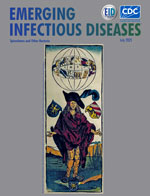
Talaromycosis is a life-threatening fungal disease that primarily affects immunocompromised persons in Southeast Asia. We conducted a multicenter, case–control study recruiting participants with advanced HIV disease in Vietnam; 205 case-patients with culture-confirmed talaromycosis were matched to 405 control-patients by age, sex, and CD4 count. Occupational exposure to tropical plants (odds ratio [OR] 1.73 [95% CI 1.10–2.73]; p = 0.017) and to farmed animals (OR 2.07 [95% CI 1.20–3.55]; p = 0.009) were independent risk factors for talaromycosis. Talaromycosis risk was higher in participants from highland regions than in persons from lowland regions (p<0.05). Participants from lowland regions who had lived or traveled to highland regions had a higher risk for talaromycosis (OR 3.15 [95% CI 1.49–6.64]; p = 0.003). This study confirms the epidemiologic correlation between talaromycosis and soil exposure and demonstrates an epidemiologic link between talaromycosis and residence in or travel to highland regions of Vietnam.
| EID | Brown L, Jonat B, Ly V, Tung N, Lam PS, Thanh N, et al. Multicenter Case–Control Study of Behavioral, Environmental, and Geographic Risk Factors for Talaromycosis, Vietnam. Emerg Infect Dis. 2025;31(7):1309-1318. https://doi.org/10.3201/eid3107.250143 |
|---|---|
| AMA | Brown L, Jonat B, Ly V, et al. Multicenter Case–Control Study of Behavioral, Environmental, and Geographic Risk Factors for Talaromycosis, Vietnam. Emerging Infectious Diseases. 2025;31(7):1309-1318. doi:10.3201/eid3107.250143. |
| APA | Brown, L., Jonat, B., Ly, V., Tung, N., Lam, P. S., Thanh, N....Le, T. (2025). Multicenter Case–Control Study of Behavioral, Environmental, and Geographic Risk Factors for Talaromycosis, Vietnam. Emerging Infectious Diseases, 31(7), 1309-1318. https://doi.org/10.3201/eid3107.250143. |
Volume 31, Number 6—June 2025
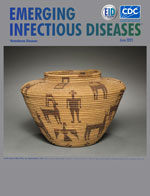
During 2007–2020, we conducted a cross-sectional prevalence study among patients with acute undifferentiated febrile illness to describe the burden and long-term epidemiology of rickettsioses in Cambodia. Serum samples were collected from 10,243 participants, along with epidemiologic data, information on clinical symptoms, demographic characteristics, and risk factors. A total of 802 (7.8%) participants met the definition for acute rickettsial infection after ruling out malaria, influenza, dengue, and chikungunya; 557 (5.4%) cases were typhus, 154 (1.5%) spotted fever, and 136 (1.3%) scrub typhus. Overall seroprevalence was 18.1% (1,857/10,243). Increased age, residence in urban settings, and recent travel to forests were significantly associated with rickettsial infection. Symptoms significantly associated with infection included rash, vomiting, and skin lesions. Our results confirm the underlying burden of rickettsioses and associated risk factors in Cambodia and highlight the need for accessible diagnostics and clinical guidance that consider rickettsioses when treating persons with acute undifferentiated febrile illness.
| EID | Kelly GC, Rachmat A, Tran L, Supaprom C, Phireak H, Prom S, et al. Clinical Manifestations, Risk Factors, and Disease Burden of Rickettsiosis, Cambodia, 2007–2020. Emerg Infect Dis. 2025;31(6):1069-1080. https://doi.org/10.3201/eid3106.241752 |
|---|---|
| AMA | Kelly GC, Rachmat A, Tran L, et al. Clinical Manifestations, Risk Factors, and Disease Burden of Rickettsiosis, Cambodia, 2007–2020. Emerging Infectious Diseases. 2025;31(6):1069-1080. doi:10.3201/eid3106.241752. |
| APA | Kelly, G. C., Rachmat, A., Tran, L., Supaprom, C., Phireak, H., Prom, S....Letizia, A. G. (2025). Clinical Manifestations, Risk Factors, and Disease Burden of Rickettsiosis, Cambodia, 2007–2020. Emerging Infectious Diseases, 31(6), 1069-1080. https://doi.org/10.3201/eid3106.241752. |
Spiroplasma ixodetis has been reported to cause the rare combination of cataract and uveitis in infants. Through a retrospective analysis of available literature and additional unpublished cases, we identified 28 eyes from 18 infants from 8 countries in Europe with cataracts and intraocular inflammation. The cataracts were bilateral in 55.6%, unilateral in 44.4%, and progressive in 46.4% of patients. Granulomatous anterior uveitis was found in all infants. Presence of S. ixodetis was supported by PCR (positive in 89.3% of eyes tested), transmission electron microscopy (positive in 90% of eyes tested), or culture of aspirated lens material (positive in 87.5% of eyes tested). Treatment with macrolide antimicrobial drugs, corticosteroids, and lensectomy appeared to be effective. Two patients had a recurrence of the uveitis after lens extraction and needed prolonged treatment. To increase awareness of S. ixodetis, we suggest its inclusion with the organisms of the TORCH acronym.
| EID | Van Os L, Cassoux N, Cholidis S, Dureau P, Farassat N, Fierz F, et al. Multicenter Retrospective Study of Spiroplasma ixodetis Infantile Cataract in 8 Countries in Europe. Emerg Infect Dis. 2025;31(6):1081-1089. https://doi.org/10.3201/eid3106.240954 |
|---|---|
| AMA | Van Os L, Cassoux N, Cholidis S, et al. Multicenter Retrospective Study of Spiroplasma ixodetis Infantile Cataract in 8 Countries in Europe. Emerging Infectious Diseases. 2025;31(6):1081-1089. doi:10.3201/eid3106.240954. |
| APA | Van Os, L., Cassoux, N., Cholidis, S., Dureau, P., Farassat, N., Fierz, F....Lorenz, B. (2025). Multicenter Retrospective Study of Spiroplasma ixodetis Infantile Cataract in 8 Countries in Europe. Emerging Infectious Diseases, 31(6), 1081-1089. https://doi.org/10.3201/eid3106.240954. |
Volume 31, Number 5—May 2025
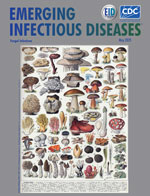
Risk factors for developing bloodstream infections (BSIs) caused by Aerococcus bacteria remain insufficiently examined. In this nationwide case–control study in Sweden, 19 of 23 clinical microbiological laboratories identified patients who had aerococcal BSIs during 2012–2016. We compared each of those index patients with 4 controls matched for age, sex, and county of residence. Overall, 588 episodes of aerococcal BSI occurred over 39.6 million person-years, corresponding to an average incidence of 1.48/100,000 person-years (95% CI 1.37–1.60/100,000 person-years). Most infections developed in men >65 years of age. Aerococcal BSI was associated with neurologic (adjusted odds ratio 2.89 [95% CI 2.26–3.70]) and urologic (adjusted odds ratio 2.15 [95% CI 1.72—2.68]) conditions and previous hospitalization or infection treatment. Our findings support the previously observed predilection for aerococcal BSIs developing in elderly men with urinary tract disorders. Awareness of Aerococcus spp. in patients, especially elderly men, will be needed to manage invasive infections.
| EID | Walles J, Inghammar M, Rasmussen M, Sunnerhagen T. Nationwide Observational Case–Control Study of Risk Factors for Aerococcus Bloodstream Infections, Sweden. Emerg Infect Dis. 2025;31(5):917-928. https://doi.org/10.3201/eid3105.240424 |
|---|---|
| AMA | Walles J, Inghammar M, Rasmussen M, et al. Nationwide Observational Case–Control Study of Risk Factors for Aerococcus Bloodstream Infections, Sweden. Emerging Infectious Diseases. 2025;31(5):917-928. doi:10.3201/eid3105.240424. |
| APA | Walles, J., Inghammar, M., Rasmussen, M., & Sunnerhagen, T. (2025). Nationwide Observational Case–Control Study of Risk Factors for Aerococcus Bloodstream Infections, Sweden. Emerging Infectious Diseases, 31(5), 917-928. https://doi.org/10.3201/eid3105.240424. |
Invasive aspergillosis (IA) caused by Aspergillus flavus remains poorly described. We retrospectively analyzed 54 cases of IA caused by A. flavus reported in France during 2012–2018. Among cases, underlying IA risk factors were malignancy, solid organ transplantation, and diabetes. Most (87%, 47/54) infections were localized, of which 33 were pleuropulmonary and 13 were ear-nose-throat (ENT) infection sites. Malignancy (70% [23/33]) and solid organ transplantation (21% [7/33]) were the main risk factors in localized pulmonary infections, and diabetes mellitus was associated with localized ENT involvement (61.5%, [8/13]). Fungal co-infections were frequent in pulmonary (36%, 12/33) but not ENT IA (0 cases). Antifungal monotherapy was prescribed in 45/50 (90%) cases, mainly voriconazole (67%, 30/45). All-cause 30-day case-fatality rates were 39.2% and 90-day rates were 47.1%, and rates varied according to risk factor, IA site, and fungal co-infections. Clinicians should remain vigilant for A. flavus and consider it in the differential diagnosis for IA.
| EID | Bertin-Biasutto L, Paccoud O, Garcia-Hermoso D, Denis B, Boukris-Sitbon K, Lortholary O, et al. Features of Invasive Aspergillosis Caused by Aspergillus flavus, France, 2012–2018. Emerg Infect Dis. 2025;31(5):896-905. https://doi.org/10.3201/eid3105.241392 |
|---|---|
| AMA | Bertin-Biasutto L, Paccoud O, Garcia-Hermoso D, et al. Features of Invasive Aspergillosis Caused by Aspergillus flavus, France, 2012–2018. Emerging Infectious Diseases. 2025;31(5):896-905. doi:10.3201/eid3105.241392. |
| APA | Bertin-Biasutto, L., Paccoud, O., Garcia-Hermoso, D., Denis, B., Boukris-Sitbon, K., Lortholary, O....Lanternier, F. (2025). Features of Invasive Aspergillosis Caused by Aspergillus flavus, France, 2012–2018. Emerging Infectious Diseases, 31(5), 896-905. https://doi.org/10.3201/eid3105.241392. |
Volume 31, Number 4—April 2025
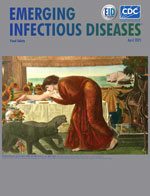
Tularemia, a zoonosis caused by Francisella tularensis, is endemic in Baden-Wuerttemberg, Germany. To determine tularemia epidemiology in this region, we characterized the genetic diversity of F. tularensis in human and animal isolates during 2012–2022 by using whole-genome sequencing, combined with human and veterinary surveillance data analysis. Human case numbers varied; most cases occurred in 2021 (n = 34). Arthropod bites were reported most in cases with information on animal exposure (45%, n = 43). Poisson regression confirmed a significant increase in human cases during the study period (p<0.001). No seasonal pattern was identified, but case numbers were lowest in winter. Human surveillance data often lacked exposure details. Positivity rates in animals were 5%–34%, increasing since 2017. Human isolates often clustered with hare-derived strains, although transmission routes often remain unclear. These findings emphasize the importance of combining genome sequencing with detailed epidemiologic tracing to identify infection sources and improve surveillance data.
| EID | Nothdurfter S, Linde J, Sting R, Tomaso H, Heuner K, Meincke M, et al. Epidemiology of Tularemia among Humans and Animals, Baden-Wuerttemberg, Germany, 2012–2022. Emerg Infect Dis. 2025;31(4):678-688. https://doi.org/10.3201/eid3104.240414 |
|---|---|
| AMA | Nothdurfter S, Linde J, Sting R, et al. Epidemiology of Tularemia among Humans and Animals, Baden-Wuerttemberg, Germany, 2012–2022. Emerging Infectious Diseases. 2025;31(4):678-688. doi:10.3201/eid3104.240414. |
| APA | Nothdurfter, S., Linde, J., Sting, R., Tomaso, H., Heuner, K., Meincke, M....Wagner-Wiening, C. (2025). Epidemiology of Tularemia among Humans and Animals, Baden-Wuerttemberg, Germany, 2012–2022. Emerging Infectious Diseases, 31(4), 678-688. https://doi.org/10.3201/eid3104.240414. |
Volume 31, Number 3—March 2025

A previous study demonstrated noninferior efficacy of 4-month rifapentine/moxifloxacin regimen for tuberculosis (TB) treatment compared with the standard regimen. We explored results among study participants with diabetes. Among 2,516 randomized participants, 181 (7.2%) had diabetes. Of 166 participants with diabetes in the microbiologically eligible analysis group, 26.3% (15/57) had unfavorable outcomes in the control regimen, 13.8% (8/58) in the rifapentine/moxifloxacin regimen, and 29.4% (15/51) in the rifapentine regimen. The difference in proportion of unfavorable outcomes between the control and rifapentine/moxifloxacin arms in the microbiologically eligible analysis group was –12.5% (95% CI –27.0% to 1.9%); the difference between the control and rifapentine arms was 3.1% (95% CI –13.8% to 20.0%). Safety outcomes were similar in the rifapentine/moxifloxacin regimen and control arms. Among participants with TB and diabetes, the rifapentine/moxifloxacin arm had fewest unfavorable outcomes and was safe. Our findings indicate that the rifapentine/moxifloxacin regimen can be used in persons with TB and diabetes.
| EID | Kurbatova EV, Whitworth WC, Peddareddy L, Phillips P, Scott NA, Bryant KE, et al. Efficacy and Safety of 4-Month Rifapentine-Based Tuberculosis Treatments in Persons with Diabetes. Emerg Infect Dis. 2025;31(3):467-476. https://doi.org/10.3201/eid3103.241634 |
|---|---|
| AMA | Kurbatova EV, Whitworth WC, Peddareddy L, et al. Efficacy and Safety of 4-Month Rifapentine-Based Tuberculosis Treatments in Persons with Diabetes. Emerging Infectious Diseases. 2025;31(3):467-476. doi:10.3201/eid3103.241634. |
| APA | Kurbatova, E. V., Whitworth, W. C., Peddareddy, L., Phillips, P., Scott, N. A., Bryant, K. E....Nguyen, N. V. (2025). Efficacy and Safety of 4-Month Rifapentine-Based Tuberculosis Treatments in Persons with Diabetes. Emerging Infectious Diseases, 31(3), 467-476. https://doi.org/10.3201/eid3103.241634. |
Volume 31, Number 2—February 2025
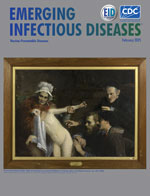
A global increase in the incidence of invasive group A Streptococcus (iGAS) infections was observed after lifting of COVID-19 related restrictions in 2022, and type M1UK dominated in many countries. After seasonal declines in iGAS incidence during the summer of 2023, simultaneous, rapid expansion of a previously rare emm type 3.93 was seen beginning in November, increasing to 20% of all cases in England and 60% of all cases in the Netherlands within 4 months. emm3.93 was associated with iGAS in children 6–17 years of age and with increased risk for pneumonia or pleural empyema and meningitis in both countries. No excess risk of death was identified for emm3.93 compared with other types. Genomic analysis of historic and contemporary emm3.93 isolates revealed the emergence of 3 new clades with a potentially advantageous genomic configuration. Our findings demonstrate the value of molecular surveillance, including long-read sequencing, in identifying clinical and public health threats.
| EID | Davies MA, de Gier B, Guy RL, Coelho J, van Dam AP, van Houdt R, et al. Streptococcus pyogenes emm Type 3.93 Emergence, the Netherlands and England. Emerg Infect Dis. 2025;31(2):229-236. https://doi.org/10.3201/eid3102.240880 |
|---|---|
| AMA | Davies MA, de Gier B, Guy RL, et al. Streptococcus pyogenes emm Type 3.93 Emergence, the Netherlands and England. Emerging Infectious Diseases. 2025;31(2):229-236. doi:10.3201/eid3102.240880. |
| APA | Davies, M. A., de Gier, B., Guy, R. L., Coelho, J., van Dam, A. P., van Houdt, R....van Sorge, N. M. (2025). Streptococcus pyogenes emm Type 3.93 Emergence, the Netherlands and England. Emerging Infectious Diseases, 31(2), 229-236. https://doi.org/10.3201/eid3102.240880. |
Human ehrlichiosis is a potentially fatal tickborne disease caused by 3 species: Ehrlichia chaffeensis, E. ewingii, and E. muris eauclairensis. In the United States, 234 confirmed cases of E. ewingii ehrlichiosis were reported to the Centers for Disease Control and Prevention through the National Notifiable Diseases Surveillance System during 2013–2021; average annual incidence was 0.08 cases/1 million population. E. ewingii ehrlichiosis was reported more commonly among older, White, non-Hispanic, and male patients. Incidence and case counts generally increased yearly, except for 2020 and 2021. The highest number of cases were reported from Missouri and Arkansas. We report the geographic expansion of E. ewingii ehrlichiosis and the continued public health challenge of clarifying clinical manifestations of this infection. Clinician education will be essential to implement molecular assays to properly diagnose E. ewingii infection in patients and gain a better understanding of the epidemiology of this emerging disease.
| EID | Adams SN, Bestul NC, Calloway KN, Kersh GJ, Salzer JS. National Surveillance of Human Ehrlichiosis Caused by Ehrlichia ewingii, United States, 2013–2021. Emerg Infect Dis. 2025;31(2):222-227. https://doi.org/10.3201/eid3102.240279 |
|---|---|
| AMA | Adams SN, Bestul NC, Calloway KN, et al. National Surveillance of Human Ehrlichiosis Caused by Ehrlichia ewingii, United States, 2013–2021. Emerging Infectious Diseases. 2025;31(2):222-227. doi:10.3201/eid3102.240279. |
| APA | Adams, S. N., Bestul, N. C., Calloway, K. N., Kersh, G. J., & Salzer, J. S. (2025). National Surveillance of Human Ehrlichiosis Caused by Ehrlichia ewingii, United States, 2013–2021. Emerging Infectious Diseases, 31(2), 222-227. https://doi.org/10.3201/eid3102.240279. |
Volume 31, Number 1—January 2025
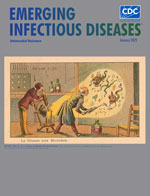
Streptococcus pneumoniae infection is considered an uncommon cause of arthritis in adults. To determine the clinical and microbiological characteristics of pneumococcal septic arthritis, we retrospectively studied a large series of cases among adult patients during the 2010–2018 conjugate vaccine era in France. We identified 110 patients (56 women, 54 men; mean age 65 years), and cases included 82 native joint infections and 28 prosthetic joint infections. Most commonly affected were the knee (50/110) and hip (25/110). Concomitant pneumococcal infections were found in 37.2% (38/102) and bacteremia in 57.3% (55/96) of patients, and underlying conditions were noted for 81.4% (83/102). Mortality rate was 9.4% (8/85). The proportion of strains not susceptible to penicillin was 29.1% (32/110). Of the 55 serotyped strains, 31 (56.4%) were covered by standard pneumococcal vaccines; however, several nonvaccine serotypes (mainly 23B, 24F, and 15A) had emerged, for which susceptibility to β-lactams was low.
| EID | Hamdad F, El Bayeh N, Auger G, Peuchant O, Wallet F, Ruimy R, et al. Pneumococcal Septic Arthritis among Adults, France, 2010–2018. Emerg Infect Dis. 2025;31(1):8-17. https://doi.org/10.3201/eid3101.240321 |
|---|---|
| AMA | Hamdad F, El Bayeh N, Auger G, et al. Pneumococcal Septic Arthritis among Adults, France, 2010–2018. Emerging Infectious Diseases. 2025;31(1):8-17. doi:10.3201/eid3101.240321. |
| APA | Hamdad, F., El Bayeh, N., Auger, G., Peuchant, O., Wallet, F., Ruimy, R....Cattoir, V. (2025). Pneumococcal Septic Arthritis among Adults, France, 2010–2018. Emerging Infectious Diseases, 31(1), 8-17. https://doi.org/10.3201/eid3101.240321. |
Rickettsia sibirica mongolitimonae is an emerging cause of tickborne rickettsiosis. Since the bacterium was first documented as a human pathogen in 1996, a total of 69 patients with this infection have been reported in the literature. Because of the rising rate of R. sibirica mongolitimonae infection cases, we evaluated the epidemiologic and clinical features of 29 patients who had R. sibirica mongolitimonae infections confirmed during 2007–2024 at the Center for Rickettsiosis and Arthropod-Borne Diseases, the reference laboratory of San Pedro University Hospital–Center for Biomedical Research of La Rioja, Logroño, Spain. We also reviewed all cases published in the literature during 1996–2024, evaluating features of 94 cases of R. sibirica mongolitimonae infection (89 in Europe, 4 in Africa, and 1 in Asia). Clinicians should consider R. sibirica mongolitimonae as a potential causative agent of rickettsiosis, and doxycycline should be administered promptly to avoid clinical complications.
| EID | Santibáñez S, Ramos-Rincón J, Santibáñez P, Cervera-Acedo C, Sanjoaquín I, de Arellano E, et al. Rickettsia sibirica mongolitimonae Infections in Spain and Case Review of the Literature. Emerg Infect Dis. 2025;31(1):18-26. https://doi.org/10.3201/eid3101.240151 |
|---|---|
| AMA | Santibáñez S, Ramos-Rincón J, Santibáñez P, et al. Rickettsia sibirica mongolitimonae Infections in Spain and Case Review of the Literature. Emerging Infectious Diseases. 2025;31(1):18-26. doi:10.3201/eid3101.240151. |
| APA | Santibáñez, S., Ramos-Rincón, J., Santibáñez, P., Cervera-Acedo, C., Sanjoaquín, I., de Arellano, E....Oteo, J. A. (2025). Rickettsia sibirica mongolitimonae Infections in Spain and Case Review of the Literature. Emerging Infectious Diseases, 31(1), 18-26. https://doi.org/10.3201/eid3101.240151. |
CME Articles by Volume
